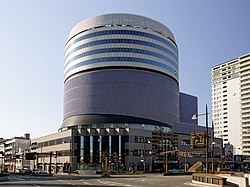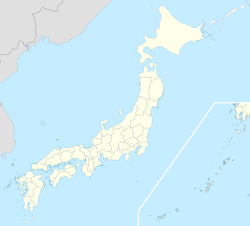Okayama
Okayama (岡山市, Okayama-shi; Japanese: [okaꜜjama]) is the capital city of Okayama Prefecture in the Chūgoku region of Japan. The Okayama metropolitan area, centered around the city, has the largest urban employment zone in the Chugoku region of western Japan. The city was founded on June 1, 1889.[1] As of February 2023[update], the city has an estimated population of 700,940 and a population density of 890 people per km2.[2] The total area is 789.95 square kilometres (305.00 square miles). The city is the site of Kōraku-en, known as one of the top three traditional gardens in Japan, and Okayama Castle, which is ranked among the best 100 Japanese castles.[3] The city is famous as the setting of the Japanese fable Momotarō.[4] Okayama joined the UNESCO Global Network of Learning Cities in 2016. HistorySengoku to Edo period In the late 16th century, during the Sengoku period (also called the Warring states period), Ukita Naoie consolidated a stronghold at Ishiyama beside the Asahi River. His successor, Ukita Hideie, shifted the main enclosure to the hill called "Okayama" and completed Okayama Castle, traditionally dated to 1597; hydrological works redirected river channels to serve as moats, and a castle town was laid out on a north–south axis.[5] After the Battle of Sekigahara, Kobayakawa Hideaki became the lord of the Okayama Domain and reconfigured the outer defenses, including the Hatsuka-bori (an outer moat reputedly finished in twenty days) and gates that defined the city's perimeter.[6] Ikeda Tadatugu, who was the feudal lord of Himeji Domain, became the next lord of Okayama. The Ikeda clan subsequently ruled Okayama and expanded the castle town.[5] Meiji period to World War II On August 29, 1871, the new Meiji government of the Empire of Japan replaced the traditional feudal domain system with centralized government authority. Okayama became the capital of Okayama Prefecture. In 1889, Okayama City was founded with the establishment of the modern municipalities system. In the Meiji period, a San'yo Main Line railroad and other local lines greatly enhanced the development of the city. The Sixth Higher Middle School (第六高等学校, Dairoku Kōtōgakkō) and Okayama Medical College (岡山医科大学, Okayama Ika-daigaku) were established in Okayama City. With modern state formation, the city developed as a regional hub for transport and education in western Japan.[7]  When World War II began, Okayama city was a garrison city for the Imperial Japanese Army.[citation needed] During the war, the city was bombed by the American forces. On 29 June 1945, air raids burned much of the urban core; the castle keep was lost.[5][6] More than 1700 people were killed.[citation needed] After the war Postwar rebuilding reestablished the central districts on the former castle-town grid. Landmarks of the modern center include the Yanagawa rotary (1959) and large-scale redevelopment in Nakasange continuing into the 21st century.[6] Okayama Castle’s keep was reconstructed in 1966, restoring the “Ujō” (“Crow Castle”) silhouette above the Asahi River.[5] During Japan's economic boom of the 1960s, Okayama developed rapidly as one of the most important cities in the Chūgoku and Shikoku regions. In 1972, the San'yō Shinkansen began service between Shin-Ōsaka and Okayama stations. Two years later, Shinkansen service was extended to Hakata. In 1988, the Seto-Ōhashi Bridge was opened, and connected Okayama with Shikoku directly by rail and road. The city became a core city in 1996 and a designated city on April 1, 2009 with increased local autonomy.[8] On March 22, 2005 the town of Mitsu (from Mitsu District), and the town of Nadasaki (from Kojima District) were merged into Okayama. This was followed on January 22, 2007 when the town of Takebe (from Mitsu District), and the town of Seto (from Akaiwa District) were merged into Okayama. Kojima, Mitsu, and Akaiwa Districts have all since been dissolved as a result of these mergers. GeographyThe city of Okayama is located in the southern part of Okayama Prefecture, which is located in western part of the island of Honshū. The northern part of the city forms a corner of Kibi Plateau, which is a series of gentle hills, and includes the Asahikawa Dam, Okayama Airport, and a suburban residential area. The central urban area is located on the Okayama Plain in the south, which was formed by the transportation and sedimentation of two first-class rivers, the Asahi River and Yoshii River, which flow into the Seto Inland Sea. To the south of the main urban area is Kojima Bay, which forms the scenic Kojima Peninsula overlooking the Seto Inland Sea. Neighboring municipalitiesClimateOkayama has a mild climate in comparison to most of Japan. It has the most rain-free days (less than 1mm of precipitation) of any city in Japan. It is ranked as the second driest and the fourth sunniest city in the Chūgoku region.[9] The climate is classified under the Köppen climate classification as humid subtropical (Cfa).[10] The local climate is warm enough throughout the year to support olive trees. Okayama is often called "Land of Sunshine" because of its low number of rainy days per year.[11]
DemographicsPer Japanese census data,[13] the population of Okayama is as follows:
GovernmentOkayama has a mayor-council form of government with a directly elected mayor and a unicameral city legislature of 46 members. The city contributes 19 members to the Okayama Prefectural Assembly. In terms of national politics, the city is divided between of the Okayama 1st District, Okayama 2nd District and Okayama 3rd District of the lower house of the Diet of Japan. Local administrationSince Okayama became a designated city in 2009, the city has been divided into four wards (ku).
Economy  AgricultureThe city is located in the Okayama Plain, where rice, eggplant, and white Chinese chives are notable products.[14] White peaches and grapes are cultivated in the mountainous, northern part of the city. IndustryIn 2005, the city's gross domestic product was 800 billion yen,[15] nearly 10% of the GDP of Okayama Prefecture. Greater Okayama, Okayama Metropolitan Employment Area, has a GDP of US$63.1 billion as of 2010.[16][17] The main industries are machine tools, chemicals, foodstuffs and printing. Kōnan, a district in the southern part of the city, is the most developed industrial zone. CommerceOkayama is the core of the Okayama metropolitan area, which includes the cities of Kurashiki and Sōja. The main commercial district is Omotechō, near Okayama Castle and Kōraku-en, and the area surrounding Okayama Station. Omotechō has many covered shopping arcades. The headquarters of Aeon Corporation, a private English language school with more than 3,000 employees, is located in Okayama.[18] Education Okayama University, founded as a medical school in 1870 and established in 1949 as a national university,[19] is in the city. Today, Okayama University is Okayama's largest university, with 8 faculties and seven graduate schools.[20] There are seven private universities, three junior colleges, 24 high schools (16 public, eight private), seven combined junior high/high schools (two public, five private), 38 junior high schools (37 municipal, one national) and 93 elementary schools (91 municipal, two private) in the city.[citation needed] Universities
Transportation Airports
RailwayJR West's Okayama Station is a major interchange, with trains from Shikoku, Sanin and San'yo connecting to the San'yō Shinkansen. Local rail lines serving Okayama Station include:
TramwayOkayama has kept an operational tram system since the Meiji period. It is managed by Okayama Electric Tramway and offers two lines: the Higashiyama Main Line and the Seikibashi Line. BusSeven bus companies provide service within the city limits: Bihoku Bus (備北バス), Chūtetsu Bus (中鉄バス), Okaden Bus (岡電バス), Ryōbi Bus (両備バス), Shimoden Bus (下電バス), Tōbi Bus (東備バス), and Uno Bus (宇野バス). Sister cities
Media The Sanyo Shimbun is the local newspaper serving the greater Okayama area. There are six television stations serving the Okayama area and part of Kagawa Prefecture. Three FM and three AM radio stations also serve the region.
SportsOkayama has many sports teams. In recent years, volleyball team Okayama Seagulls and football club Fagiano Okayama have been established. In 2009, Fagiano Okayama gained promotion to the J.League, the highest football league in Japan.
Local attractions
National Historic Sites
FestivalsEvery August since 1994 Okayama has seen the Momotarō Matsuri (Festival), which is an amalgam of three different festivals, including the Uraja 'ogre' festival, which is a kind of Yosakoi dance. Music
CuisineOkayama has several traditional dishes.Barazushi, a dish made with sushi rice, contains fresh fish from the Seto Inland Sea. Kibi dango (Okayama) (吉備団子) gel-like balls made from a powder of millet and rice, are well known sweets from the area. Notable peoplePremodern
Arts
Politics
Literature
Entertainment
Sports
Inventors
References
External linksWikimedia Commons has media related to Okayama. Wikivoyage has a travel guide for Okayama.
|
||||||||||||||||||||||||||||||||||||||||||||||||||||||||||||||||||||||||||||||||||||||||||||||||||||||||||||||||||||||||||||||||||||||||||||||||||||||||||||||||||||||||||||||||||||||||||||||||||||||||||||||||||||||||||||||||||||||||||||||||||||||||||||||||||||||||||||||||||||||||||||||||||||||||||||||||||||||||||||||||||||||||||||||||||||||||||||||||||||||||||||||||||||||||||||||||||||||||||




















